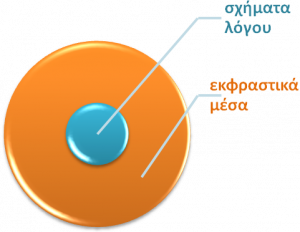Language/Modern-greek-1453/Culture/Figures-of-Speech-Definitions-and-Examples
Writing is a craft and figures of speech are one of the many tools you can use to make your speech more impactful.
A figure of speech is a creative use of language to generate an effect. Some figures of speech, like metaphor, simile, and metonymy, are found in everyday language.
Below are some common figures of speech with examples, so you can recognize them and use them in your writing:
Alliteration (Παρήχηση)
The repetition of an initial consonant sound.
Example: She sells seashells by the seashore.
Anaphora (Αναφορά)
The repetition of the same word or phrase at the beginning of successive clauses or verses.
Example: Unfortunately, I was in the wrong place at the wrong time on the wrong day.
Antithesis (Αντίθεση)
The juxtaposition of contrasting ideas in balanced phrases.
Example: As Abraham Lincoln said, "Folks who have no vices have very few virtues."
Apostrophe (Αποστροφή)
Directly addressing a nonexistent person or an inanimate object as though it were a living being.
Example: "Oh, you stupid car, you never work when I need you to," Bert sighed.
Asyndeton (Ασύνδετο)
Omission of conjunctions between related clauses.While asyndeton usually involves commas, it can also function as a series of sentences.
Example: Deftly, lightly, he entered the dark house undetected.
We tried. We failed. We learned. We will try again.
Chiasmus (Χιαστό)
A verbal pattern in which the second half of an expression is balanced against the first but with the parts reversed.
Example: The famous chef said people should live to eat, not eat to live
Circumlocution (Περίφραση)
Circumlocution is the use of a purposely wordy description. You can think of it as talking in circles.
Example: In the Harry Potter series, most characters don’t say Lord Voldemort’s name; instead, they use this circumlocution: “He Who Must Not Be Named.”
Euphemism (Ευφημισμός)
The substitution of an inoffensive term for one considered offensively explicit.
Example: We're teaching our toddler how to go potty
Hyperbole (Υπερβολή)
An extravagant statement; the use of exaggerated terms for the purpose of emphasis or heightened effect.
Example: I have a ton of things to do when I get home.
Irony (Ειρωνεία)
The use of words to convey the opposite of their literal meaning. Also, a statement or situation where the meaning is contradicted by the appearance or presentation of the idea.
Example: "Oh, I love spending big bucks," said my dad, a notorious penny pincher.
Litotes (Λιτότητα)
A figure of speech consisting of an understatement in which an affirmative is expressed by negating its opposite.
Example: A million dollars is no small chunk of change
Metaphor (Μεταφορά)
An implied comparison between two dissimilar things that have something in common.
Example: "All the world's a stage."
Metonymy (Μετωνυμία)
A figure of speech in which a word or phrase is substituted for another with which it is closely associated; also,
the rhetorical strategy of describing something indirectly by referring to things around it.
Example: "That stuffed suit with the briefcase is a poor excuse for a salesman," the manager said angrily.
Onomatopoeia (Ονοματοποιία)
The pronounciation of the word imitates a sound, a story becomes more lively and interesting by the use of onomatopoeia.
Examples: The lion roared , the steaks sizzled in the pan, the bomb went off with a bang.
Oxymoron (Οξύμωρο)
Oxymoron is a figure of speech pairing two words together that are opposing and/or contradictory. This combination of contrary or antithetical words is also known
in conversation as a contradiction in terms. As a literary device, oxymoron has the effect of creating an impression, enhancing a concept, and even entertaining the reader.
Examples:
Friendly fire
Virtual reality
Controlled chaos
Freezer burn
Silent scream
Terribly good
Wise fool
Parallelism (Παραλληλισμός)
Successive clauses or sentences are similarly structured. This similarity makes it easier for the reader / listener to concentrate on the message.
Examples: We are bound by ideals that move us beyond our backgrounds, lift us above our interest, and teach us what it means to be citizen
Personification (Προσωποποίηση)
Attribution of human characteristics to animals, inanimate objects as having human characteristics.
Examples:
The flowers nodded their heads as if to greet us.
The frogs began their concert.
Pleonasm (Πλεονασμός)
Pleonasm is derived from a Greek word that means “excess.” It is a rhetorical device that can be defined as the use of two or more words (a phrase) to express an idea.
These words are redundant, such as in these examples of pleonasm” :
“burning fire,” and “black darkness.”
Sometimes, pleonasm is called “tautology,” which is the repetition of words.
Simile (Παρομοίωση)
There are many common examples of simile used in everyday conversation and writing. Here are some well-known phrases that utilize this figure of speech:
Eyes like glass
Slept like a log
Sly as a fox
Fits like a glove
Cool as a cucumber
Blind as a bat
Light as a feather
Synecdoche (Συνεκδοχή)
Synecdoche is some kind of generalization or specification that uses a part, a member or a characteristic of what is meant.
Examples:
Turning our long boat round on the last morning required all hands on deck … (hands = people)
Troops halt the drivers (troops = soldiers)
Author
- Ευγενική χορηγία που στοχεύει να βοηθήσει μαθητές ή μη, απανταχού της Γης, που επιδίδονται στην εκμάθηση της ελληνικής γλώσσας!
- Contribution bénévole visant à aider les personnes, partout dans le monde, qui sont engagées dans l'apprentissage de la langue grecque !
- Voluntary contribution aimed at helping people, all over the world, who are committed to learning the Greek language!

